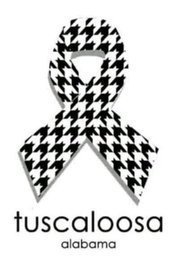 1.
1.
A month ago I was tying a red polka-dotted, pink ribbon and white satin bow to the trunk of a cherry tree. The viewing of the cherry blossoms, sakura, was waning, the petals left on the bloom ragged, muscled aside by the surging green leaves, the sublime and melancholy image of a fall in the spring.
The orchard is in a field at the crook where the Interstate stub branches into the one-way arteries of Lurleen Wallace Boulevard, circulating into the heart of downtown Tuscaloosa.
We have a sister city, Narashino, in Japan, recovering, then and now, from the tsunami, the earthquake. The ribbons are a token, a kind of meditation on our fragile, distant connection.
Organized quickly, the group, a handful of volunteers, fanned out through the orchard. Our arms cradled the notions. It looked as if we were attempting to reattach bouquets of petals to the blown trees.
Our task complete, there were pictures to be taken, posed before the bedecked trees. Cars, trucks on either side zoomed. We stood still, better to be captured still. Around us a light breeze lifted the shimmering spotted ribbons, a kind of sigh. The air plucked more petals from the blossoms and spun them around and around. Our friends in Japan reported back to us that in the wreck of tsunami they had found a few cherry blossoms to regard.
Posed, we gazed off into that distance beyond the photographer, assessed the perspective, the cleaved road coming together pointing south.
A month later, the tornado stepped over that highway, there, just at the vanishing point, wedged its way into the city.
2.
The school where I teach advertises itself as The University of Alabama—Touching Lives. The televised graphic is a pulse generated in a classroom, an expanding circle ever-widening as the camera pulls out further and further even into outer-space, that ripple, that wave emanating from little ol’ Tuscaloosa, there below, a speck of dirt on the moldy map of earth.
Teaching my students haiku, I have them consider the architecture of contrast. A minute gesture juxtaposed against the infinite. I take them out to Marrs Spring, the water source the college grew up around beginning in the 1830s. We watch frogs jump into the old pond, see the ripples ripple outward. Each composes a verse on the spot, using cell phone, texting the poem to a friend, a relative. I remind them that we live now in this electro-magnetic soup—text, data, digital dots and dashes emanating invisibly all around us until we draw them back out of the congested air. A few telling words. “Where are you now?”
They send their poems out into the world. We wait, contemplate the still water. Then their devices, a chorus, suddenly animate in their hands, begin to vibrate and croak, announcing, reverberating, the responses. From near. From far.
Last night, I had a little power at my house as the darkness settled over us all. I sent out pulses into space. My students, scattered by the storm, still clutched that rapidly diminishing charge in their hands. Their phones retained some spark. They echoed back. Outside, the thick air—still sultry, saturated, heavy—transmitted the sawing of actual frogs in nearby gullies and sloughs. “Here.” And “here.” And “here.” The box in my palm peeped. Spent, ratcheted down, one-by-one, the tiny tinny flashes fewer and fewer as the batteries elsewhere everywhere died. There and there and there. And, then, all that nothing.
3.
In Tuscaloosa, there is a woman, a neighbor, who walks every day from one side of town to the other, west to east to west. As she walks, she rants and preaches, cannot be persuaded to stop, cannot be talked to. She walks.
There was plenty of warning yesterday. Sirens. I raced home from campus, west by car into the rain wall, distant, the approaching storm working its way up the Black Warrior River.
Just blocks from both our homes, I catch up with the woman who walks, not walking, standing in the empty space on the corner of MLK and 6th. The space, there, is fallow, an open field, a ruin, still, of the 1840 tornado that cleared Newtown, Alabama, from the map. A nearby plaque attests to that disaster. The woman spreads open the folds of her poncho. Sails unfurling in the mounting wind, the cape whipping all around her. Then, her head down, into the wind, she walks the rest of the way home.
—
Michael Martone teaches in the University of Alabama’s esteemed MFA program.
